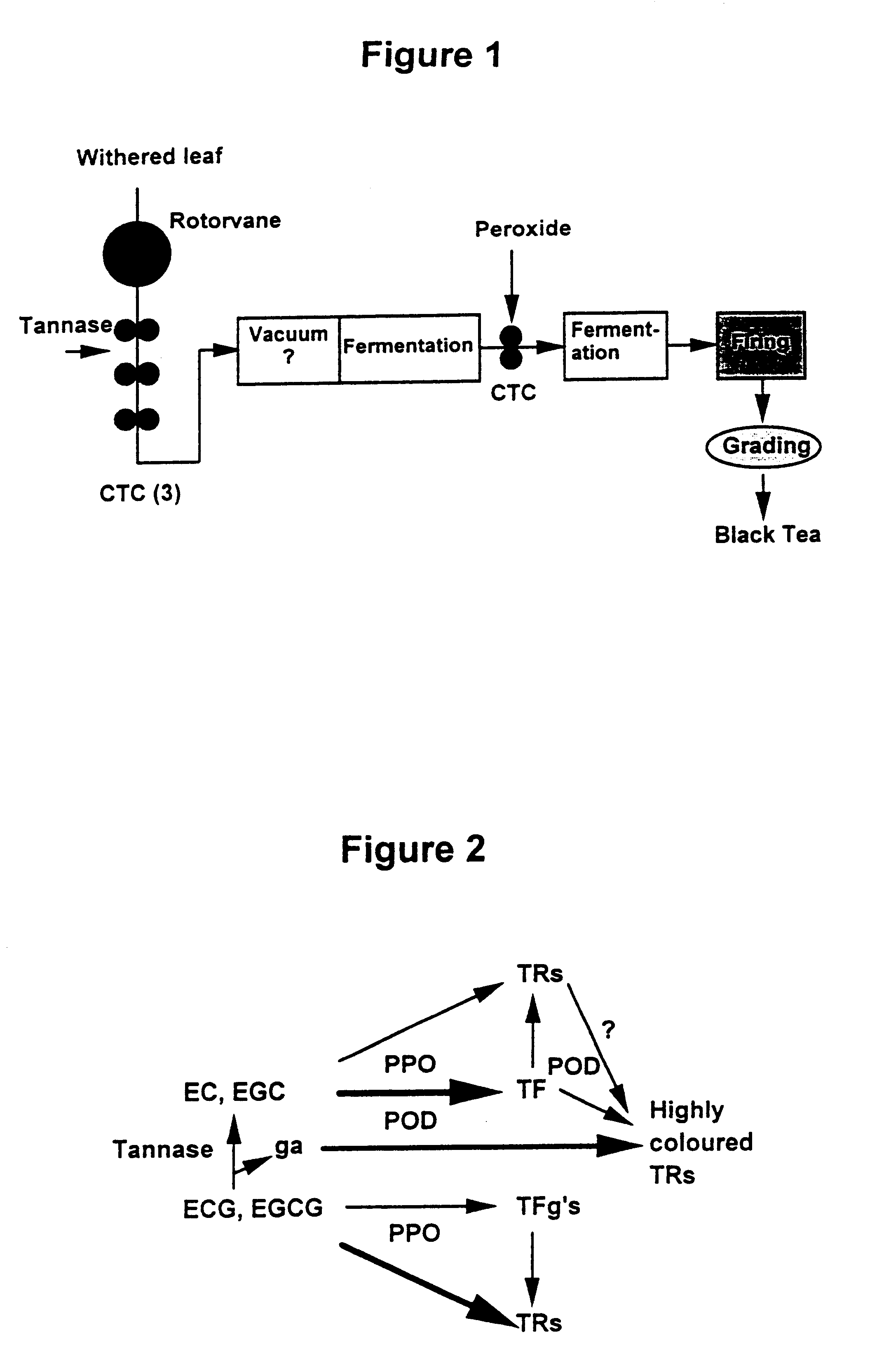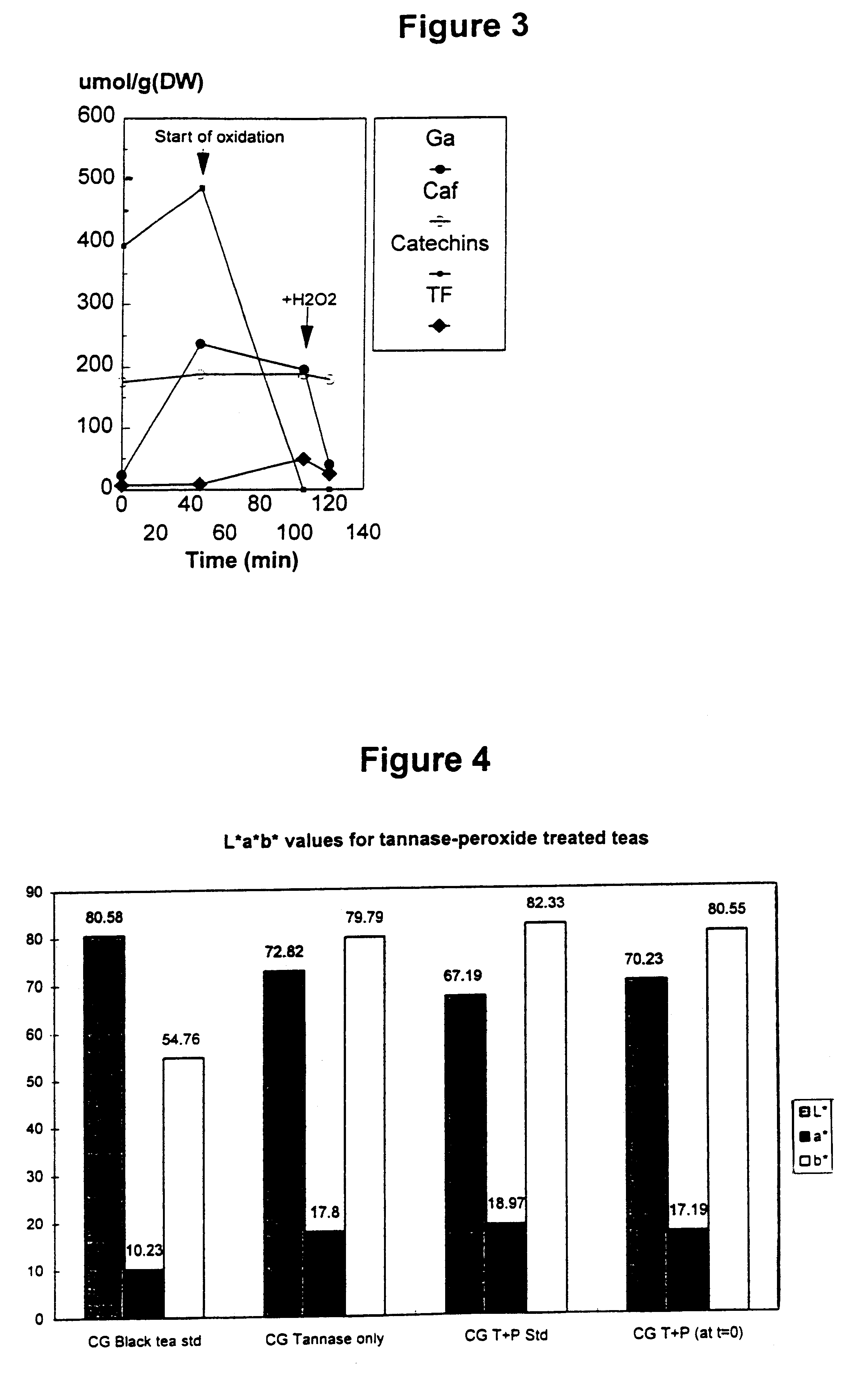Cold water infusing leaf tea
- Summary
- Abstract
- Description
- Claims
- Application Information
AI Technical Summary
Benefits of technology
Problems solved by technology
Method used
Image
Examples
example 2
Colour Comparison with Other Products
Dhool was treated in treated in accordance with the basic lab scale process described above (60 mg tannase, dried immediately after peroxide addition). The colour of the liquor obtained from this product was compared with that obtained from a commercially available product (SMOOTHBLEND.TM.) and a tea sample prepared from a standard fermentation of Kenyan tea leaf, all at 2.27 g black tea / 200 ml chilled tap water, 5 minutes infusion. The results are summarised in Table 2 below. Note, these values are for tap water infusions which gives darker colours than infusions in distilled water.
These results show the tannase / peroxide process on the invention gave a liquor whose colour was significantly brighter, redder and yellower than that obtained from the untreated Kenyan tea or the SMOOTHBLEND.TM. product.
example 3
Comparison of Standard, Tannase Only, Tannase Peroxide (Different Times of Addition) Processes
Infusions were made for samples of a black tea standard, tannase treated black tea, tannase-peroxide treated black tea wherein the peroxide was added after 60 minutes fermentation, and tannase-peroxide treated black tea wherein the peroxide was added at t=0. In each case 2.27 g tea was brewed for 5 minutes in 200 ml HIGHLAND SPRING.TM. still spring water at room temperature. The colour characteristics of each were measured using a MINOLTA transmission calorimeter. The results are represented in FIG. 4.
These results and product tastings demonstrate that the combination of tannase treatment and hydrogen peroxide addition, after partial fermentation, are required to maximise the delivery of colour and flavour. Tannase only samples were observed to possess a "sour" or "metallic" taste thought to be derived from the elevated levels of gallic acid.
The lab scale process described above was repeate...
example 4
Investigation of the Use of a Vacuum to Optimise Tannase Effectiveness
The experiments that are described below were carried out using some standardised materials and methods. For completeness these are as follows:
Materials
Experiments were carried out with Kenyan leaf of BBK (Brooke Bond Kenya) clone 35, withered overnight at Mabroukie factory and air-freighted to the UK frozen on dry ice. This leaf was stored frozen at -80.degree. C. until use. Tannase was from Kikkoman's Co, Japan and "Macer8 W".TM. from Biocatalysts Ltd, Wales.
Tannase Treatment
Batches of dhool were prepared from frozen leaf of BBK 35 and stored at -80.degree. C. Portions of the batch were analysed for initial catechin composition and the remainder used in experiments. Experiments were carried out with various amounts of dhool; 8 g (for the standard experiment) to 100 g (for the scale up experiment). When more than 8 g was used the volume of tannase solution was scaled up appropriately.
Eight grams of dhool were tha...
PUM
 Login to View More
Login to View More Abstract
Description
Claims
Application Information
 Login to View More
Login to View More - R&D
- Intellectual Property
- Life Sciences
- Materials
- Tech Scout
- Unparalleled Data Quality
- Higher Quality Content
- 60% Fewer Hallucinations
Browse by: Latest US Patents, China's latest patents, Technical Efficacy Thesaurus, Application Domain, Technology Topic, Popular Technical Reports.
© 2025 PatSnap. All rights reserved.Legal|Privacy policy|Modern Slavery Act Transparency Statement|Sitemap|About US| Contact US: help@patsnap.com



